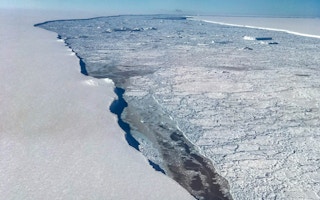The vast southern ice sheet, despite the Antarctic buffer which has protected it for so long, is now being threatened by ocean swells chipping away at the continent’s coastal edge, says a new study by US scientists published in the journal Nature.
For millennia the southern ice sheet has had this protective buffer of sea ice ringing its coastal shelves. But now the swells from the north are flexing them and can weaken their stabilising seaward edge. Regular inundation by summer meltwater as the edge breaks away can also contribute to rapid ice shelf disintegration.
Ice shelves, with their ring of sea ice, are thick plates of ice fed by tributary glaciers, floating seaward extensions of the massive grounded inland ice sheet. They slow the flow of ice from the sheet, so rapidly disintegrating shelves have implications for sea level rise.
“Sea ice here acts like the bumpers on a car—with the bumpers in place, the car can take a shock and not be damaged. Take them off, and every hit adds up,” said Ted Scambos, study co-author and senior research scientist at the National Snow and Ice Data Centre at the University of Colorado Boulder.
Since 1995, three large ice shelves on the Antarctic Peninsula—Larsen A, Larsen B and Wilkins—have suddenly and dramatically disintegrated.
Occurring over a few weeks, or sometimes even only a few days, these break-ups mark an unprecedented departure from the more typical and natural recurring calving of larger icebergs every decade or so.
“
Sea ice acts like the bumpers on a car—with the bumpers in place, the car can take a shock and not be damaged. Take them off, and every hit adds up.
Ted Scambos, scientist, National Snow and Ice Data Centre, University of Colorado Boulder
Trigger found
Until recently researchers had thought intense surface melting caused by a warming climate and ice fracturing were the sole culprits. But the new findings suggest that loss of sea ice and the calving of the seaward edge into narrow sliver-like icebergs are the trigger that sets off a rapid ice shelf disintegration.
“Our study breaks new ground in how it implicates sea ice change in sea level rise,” said Rob Massom, the study’s lead author and a senior research scientist at the Australian Antarctic Division and Antarctic Climate and Ecosystems Cooperative Research Centre.
“It introduces ocean wave-induced breakage of the outer margins of ice shelves following loss of a protective sea ice buffer as the straw that breaks the camel’s back.”
He and his colleagues analysed disintegrations on three ice shelves that had been stable for centuries or even millennia: Larsen A in 1995, Larsen B in 2002, and Wilkins in 2008 and 2009.
They confirmed that atmospheric warming led to increased meltwater on the surfaces of the shelves. Pooled meltwater then percolated downward through crevasses, setting off a hydrofracturing process that weakened the ice.
Earlier studies have identified the central role that ice shelves play in making sea level rise more likely and the accelerating pace of Antarctic melting.
But, crucially, what the NSIDC analysis reveals is a previously little-recognised link to sea ice: all three disintegrations happened when there was little or no sea ice cover along the shelf edge. Without that protective buffer, the shelves became exposed to waves which flexed the already fractured ice.
“What we’ve found is that increased flexing of the outer parts of ice shelves by waves sets the ice up for destruction. Even though the movement is tiny, over time the shelf is weakened,” Scambos said.
In each case, ocean swells began affecting the ice shelf edge. As the shelves flexed, existing fractures along the seaward edge chipped off as long, thin, sliver-shaped icebergs, not the larger tabular icebergs more typical of Antarctic ice shelf calvings. The remaining ice shelf was then ripe for runaway collapse.
“Other ice shelves can survive for centuries if they don’t have surface meltwater—or if the water can run off easily,” Scambos said. “But with meltwater ponding and a legacy of weakening from sea ice loss, you can destroy a shelf in just a few weeks.”
Pressure off
Because ice shelves are already floating in the ocean and displacing their volume, like ice cubes in a glass of water, their disintegration does not contribute directly to sea level rise.
But they do provide a backpressure that moderates glacier flow speed. Once they’re gone, so is the backpressure, allowing the glaciers to flow more rapidly into the ocean and ultimately contribute to sea level rise.
“This represents an important pathway towards reducing current large uncertainty in predictions of the response of the Antarctic cryosphere to climate change and its contribution to sea level rise,” Dr Massom said.
The Antarctic ice sheet contains enough ice to raise sea level by approximately 57 metres (187 feet), about half the length of a soccer pitch. Worldwide, more than 100 million people currently live within 1m of mean sea level.
This story was published with permission from Climate News Network.










